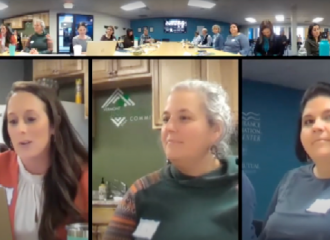
Earlier this year, we sent out our annual BBF Network Partner Survey asking for feedback on our partners’ experiences with the State Advisory Council, one of our Regional Councils, a VECAP Committee, or with BBF as an organization during the previous year. We’re pleased to share the survey results, which we are using as part of the continuous quality improvement cycle for the Network to meet BBF’s five key mandates: Empowering, Convening, Monitoring, Responding, and Advising.
BBF’s mission is to improve the well-being of children and families by using data and by bringing voices together across sectors and within regions to discuss challenges in the early childhood system. To this end, we use the Network Partner Survey data to improve our meeting structure, policy development, and engagement with diverse partners. This year, we would like to highlight the findings related to how we make the BBF Network a place of belonging with diversity, equity, access, and inclusion front of mind. Here are a sampling of the responses related to accommodations and DEIJ (diversity, equity, justice, and inclusion).
Accommodations Findings
The survey asked, “What accommodations, if any, can BBF provide in meetings or written correspondence to support all abilities?”
Meetings
Respondents mentioned a range of accommodations that could help to make meetings more accessible. In advance of meetings, respondents asked that agendas be shared ahead of time when possible, materials offered in other languages as needed, sign language interpretation made available, and that schedulers determine the best times and formats (in-person, virtual, hybrid) for meetings to meet the needs of all participants. During meetings, respondents asked for captioning options and for agendas to be shared in the chat during Zoom meetings. After meetings, they would like to see recordings with captioning, notes (including a high-level summary), and transcriptions (in multiple languages if possible).
Communications
Survey respondents would like to see a variety of reading levels in written material, including bulleted messaging and plain language. There were requests for translated materials including Braille; visual ways of communicating, including short videos instead of emails; hard copies of publications and forms; communications that work well for neurodivergent people; and materials that are accessible to Deaf and Deaf/blind people.
Website/Media
Respondents asked for captions, alt text, more accessible text colors on graphics, and webpages that work well with screen readers. They also requested a calendar of events and meetings on the website. Many of these items are already in progress as Building Bright Futures prepares to launch a new website with a fully functional events calendar and many other accessibility improvements.
Findings with a DEIJ Focus
These are the responses that relate to diversity, equity, justice, and inclusion (DEIJ). Building Bright Futures staff are working to incorporate these suggestions and represent a network that truly represents all Vermonters.
Demographics
We asked respondents to self identify to better understand who is currently represented in our network.
Gender
- 87% identified as female
- 9% preferred not to answer
- 4% identified as male, non-binary, or self described in another way
Race
- 92% identified as white
- 8% identified as American Indian or Alaska Native, Hispanic or Latino, Middle Eastern or North African, and/or preferred not to answer
When asked “Is there something in your life you bring to the table?”
- 36% mentioned a personal or professional connection to mental health
- 27% identified that they have lived experience with a disability themselves or are parenting a child with disabilities or special health needs
- 14% identified as part of the LGBTQIA+ community
- Respondents represented a variety of different religions, family makeup, and lived experiences
- There were respondents who identified that substance use disorder impacts their personal or professional life
Diversity
These suggestions help BBF understand if the BBF Network, committee meetings, events, etc. respectfully include diverse perspectives, experiences, and identities.
- “Work with committees on efforts to diversify committee membership as well as BBF state team representation.”
- “Recognize/elevate the role of providers of various socio-economic levels and their lived experience.”
- “Create resources in multiple languages and include outreach to underserved populations. Engage more regional community partners that support diverse populations. Especially considering economically diverse populations and LGBTQ+ in younger children especially.”
Inclusion
The BBF Network begins by having diverse perspectives at the table, but it does not end there. As the state’s advisory council on early childhood systems, BBF works to elevate the voices of those impacted by early childhood systems into decision-making processes.
- “Become a presence and a resource at community events that focus on DEI that involve children and families. Community or college arts and culture nights, library programs, family groups, etc.”
- “Diversify family voice—find ways to bring in under-represented families to hear about their experiences when there may be challenges in bringing them to the tables—how to increase engagement where the onus isn’t on them to bring their experiences to the network.”
- “Include the voices of the individuals with intellectual and developmental disabilities, not just their caregivers.”
Equity
Respondents asked for a range of increased accommodations, including more plain language communications, closed captioning, and interpreter services. More equitable meeting spaces and community spaces will help to transform unjust power structures.
- Regularly ask “What accommodations are needed?” in Zoom registration.
- “More in-person meetings to meet people where they are at.”
- “Offer more ground-level opportunities for families to engage. BBF feels like overall a very professional- or provider-based group, all working for the betterment of families and children. But it can be hard for parents to figure out how to participate.”
- Find ways to simplify what BBF is and what we do.
- Create space for “open forums” and frank conversations in a structured and supportive way.
Justice
These recommendations point out where BBF can help navigate opportunities towards healing, reconciliation, and restoration of relationships. What is BBF doing to remove barriers to justice and to prevent harm for all individuals?
- “Champion resources, projects, policies, and organizations specifically designed by and for BIPOC, LGBTQ+, disabled, immigrant Vermonters.”
- Provide more trauma-responsive care and systemic trauma trainings.
- “Involve and implement practices from national leaders in the area of diversity, equity, inclusion, and belonging—not just providing one and done trainings, meetings, information sessions—actually applying it to work and holding child cares and those overseeing child care accountable for practices.”
- “Focus on outcomes. How many childcare spots are there? How often are centers closing for a day or more at a time and causing disruption to families? Which centers border on closing entirely due to financial problems, leadership issues, real estate problems? The theory of change needs to be revisited. The focus on ‘quality’ at any cost caused an apocalypse of small provider closures, and now the focus on funding based on financial need, not the broader needs of all families, is so narrow that you’re missing the ongoing crisis affecting working families.”


